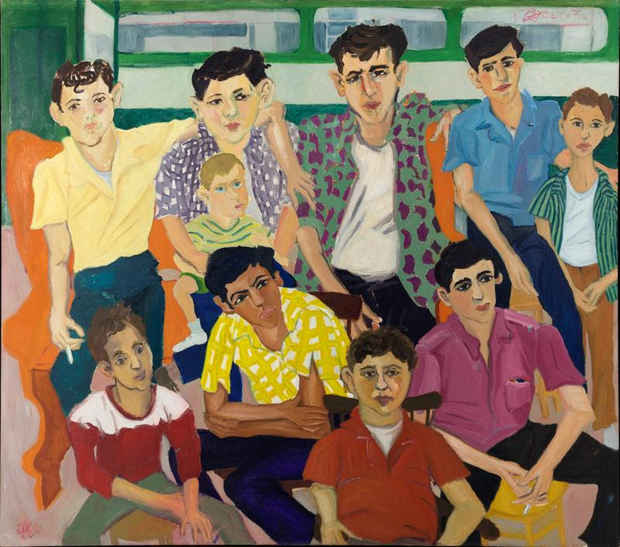Mimi Gross “Among Friends 1958-1963”
Eric Firestone Gallery

[Image: Mimi Gross "Grand Street Boys" (1963) oil on canvas | 60 x 70 in.]
This event has ended.
Eric Firestone Gallery presents Mimi Gross: Among Friends, 1958-63. The exhibition will focus on Mimi Gross’s early paintings and works on paper. They are portraits of her friends, family, and acquaintances in the communities she lived in and traveled through, from the Lower East Side of Manhattan to Florence, Italy.
Mimi Gross considers portraiture a form of mutual collaboration. Her paintings have a poignant expressiveness and connection to the subject. Hers is a world of bold, unapologetic color. In this way it looks back to Fauvist painting, and German expressionism. The directness of Gross’s portraiture, and her propensity to paint all aspects of her community (neighbors, acquaintances, and significant members of the art world) can be linked in particular to the work of Alice Neel. Neel was a close friend and supporter of Gross’s work, and she painted Gross and Red Grooms (who was Gross’s husband and artistic collaborator from 1960-76) in two double portraits. Like Neel, Gross is after an essential, emotional likeness, captured through gestural immediacy.
In her works on paper, Gross uses oil crayon and chalk pastel, which remains a favored, signature medium for the artist. The pastel and oil crayon medium lends itself to a direct, unfussy approach. Her crayon drawings, said to been an influence on Bob Thompson, feel relevant in relation to contemporary artists such as Katherine Bradford and Tal R.
Gross was born in 1940 and grew up in South Harlem in Manhattan. Her father was Chaim Gross, the sculptor known for woodcarving. Her parents were consummate art collectors with a vast network of art world friends and colleagues.
Gross grew up surrounded by art and artists, who traversed stylistic categories. For example, close friends of her parents included Raphael Soyer, Marsden Hartley, John Graham, and Reginald Marsh. The family also spent time in Provincetown, Massachusetts, engaged in that vibrant summertime art community
Gross attended high school at the High School of Music and Art (now LaGuardia High School), and entered Bard College in 1957, where she studied for two years. The exhibition begins, in a narrative sense, in this period.
In the summer of 1958, Gross lived in Provincetown and became friends with Bob Thompson. Another close friend was artist Jay Milder, who would introduce Gross to Red Grooms. In 1958, Milder and Grooms founded the City Gallery, an artist cooperative where Gross exhibited her work for the first time. Gross’s artistic circles would continually expand, including artists, filmmakers, musicians, choreographers, and poets, such as Rudy Burckhardt, Edwin Denby, Robert Whitman, Charles Atlas, Charles Bernstein, Anne Waldman, and Douglas Dunn.
In 1959, Gross traveled to Europe, taking hitchhiking trips with her friend Jackie Ferrara, the sculptor. They went to Salzburg and found a summer school run by Oscar Kokoschka. Gross became his student. She recalls that Kokoschka disapproved of her work. A favored and talented student was Evelyn Gwinner (nicknamed Gwinnie), who also became a close friend. A portrait of Gwinnie is included in this exhibition.
In 1960, Red Grooms arrived in Florence, and he and Gross spent a year together traveling in Italy, Greece, and Egypt. In the summer of 1961, along with Katharine Kean, Nello Falteri, and Pete Stanley, they traveled from Florence to Venice in a horse-drawn carriage, painted and decorated by Gross, stopping at villages to stage a shadow puppet show. The project, titled Il Piccolo Circo d’Ombre di Firenze, became raw material for dozens of paintings and works on paper made during the journey. Gross filled sketchbooks with portraits of people they encountered, landscapes of the rolling hills, and images of the piazzas, frescoes, and Duomos. Numerous sheets from the summer in Tuscany will be on view in a concentrated wall installation.
Gross also made Jewish cultural identity a significant aspect of this early work. She painted her father in the eccentric combination of a harlequin suit and a yarmulke. Jewish weddings became the subject of several paintings. She embraces, in her work and in her attitude, the idea of artistic and cultural lineage. In this sense, her early paintings can be connected to Soutine, Chagall, and R.B. Kitaj.
Gross’s work can be found in the collection of the Jewish Museum, New York; the New York Public Library; and the Metropolitan Museum of Art, New York. She is the recipient of awards and grants including from the New York State Council on the Arts, the National Endowment for Visual Arts, the American Academy and Institute of Arts and Letters, and a “Bessie” for sets and costumes. In addition, Gross is the President of the Board of the Renee and Chaim Gross Foundation. The Foundation, which houses her family’s vast collection of Modernist art and arts of Africa, is located in their former home on LaGuardia Place, and open to the public. Several of Gross’s paintings in the exhibition are part of the Foundation’s collection.
Media
Schedule
from February 28, 2019 to May 04, 2019
Opening Reception on 2019-02-28 from 18:00 to 20:00